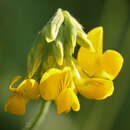Associations
provided by BioImages, the virtual fieldguide, UK
Foodplant / sap sucker
Acyrthosiphon pisum sucks sap of live Lathyrus pratensis
Foodplant / internal feeder
larva of Apion afer feeds within bud (vegetative of Lathyrus pratensis
Other: sole host/prey
Foodplant / feeds on
larva of Apion ebeninum feeds on Lathyrus pratensis
Foodplant / internal feeder
larva of Apion ervi feeds within flower bud of Lathyrus pratensis
Foodplant / internal feeder
larva of Apion pomonae feeds within pod (on unripe seeds) of Lathyrus pratensis
Other: major host/prey
Foodplant / internal feeder
larva of Apion subulatum feeds within pod (on unripe seeds) of Lathyrus pratensis
Other: sole host/prey
Foodplant / internal feeder
larva of Apion viciae feeds within flower (on anthers, pistils) of Lathyrus pratensis
Foodplant / open feeder
larva of Aprosthema melanura grazes on leaf of Lathyrus pratensis
Other: major host/prey
Plant / resting place / on
adult of Bruchus loti may be found on Lathyrus pratensis
Remarks: season: (1-)summer(-12)
In Great Britain and/or Ireland:
Foodplant / parasite
conidial anamorph of Erysiphe trifolii parasitises live Lathyrus pratensis
Foodplant / parasite
sporangium of Peronospora viciae parasitises live stem of Lathyrus pratensis
Foodplant / spot causer
colony of dematiaceous Phacellium anamorph of Phacellium carneum causes spots on fading leaf of Lathyrus pratensis
Foodplant / spot causer
colony of Ramularia deusta causes spots on live leaf of Lathyrus pratensis
Foodplant / feeds on
larva of Sitona ambiguus feeds on Lathyrus pratensis
Foodplant / feeds on
larva of Sitona suturalis feeds on Lathyrus pratensis
Other: major host/prey
Foodplant / pathogen
conidial anamorph of Thecaphora lathyri infects and damages anther of Lathyrus pratensis
Foodplant / parasite
mostly hypophyllous uredium of Uromyces pisi-sativi parasitises live leaf of Lathyrus pratensis
Foodplant / parasite
mostly hypophyllous aecium of Uromyces viciae-fabae var. viciae-fabae parasitises live leaf of Lathyrus pratensis
Description
provided by eFloras
Perennial, scrambling, stem angled, subglabrous or pubescent. Leaf paripinnately compound, leaflets 2,10-40 mm long, 1.5-11 mm broad, linear-lanceolate; stipules 10-30 mm long, ovate-lanceolate, unequally sagittate. Inflorescence a 3-12-flowered, peduncled axillary raceme, peduncle much longer than the leaf. Calyx 6-9 mm long, teeth somewhat unequal, the lowest tooth 1-2 times as long as the tube. Corolla yellow, 10-16 mm long. Fruit 2-3 cm long, 5-6 mm broad, mostly glabrous, 4-8-seeded.
- license
- cc-by-nc-sa-3.0
- copyright
- Missouri Botanical Garden, 4344 Shaw Boulevard, St. Louis, MO, 63110 USA
Distribution
provided by eFloras
Europe, Africa, W. Asia, C. Asia, Himalaya (Chitral to C. Nepal), China, Mongolia, Siberia.
- license
- cc-by-nc-sa-3.0
- copyright
- Missouri Botanical Garden, 4344 Shaw Boulevard, St. Louis, MO, 63110 USA
Distribution
provided by eFloras
Distribution: Pakistan; Kashmir; India; Caucasia eastwards to Central Asia; Iraq; Lebanon; Turkey; Exhiopia N. Africa; Europe.
- license
- cc-by-nc-sa-3.0
- copyright
- Missouri Botanical Garden, 4344 Shaw Boulevard, St. Louis, MO, 63110 USA
Physical Description
provided by USDA PLANTS text
Perennial, Herbs, Taproot present, Nodules present, Stems or branches arching, spreading or decumbent, Stems prostrate, trailing, or mat forming, Stems less than 1 m tall, Climbing by tendrils, Stems solid, Stems or young twigs glabrous or sparsely glabrate, Stems or young twigs sparsely to densely hairy, Stems winged or with decurrent stipules, Leaves alternate, Leaves petiolate, Stipules conspicuous, Stipules green, triangulate to lanceolate or foliaceous, Stipules persistent, Stipules free, Stipules cordate, lobed, or sagittate, Leaves compound, Leaves even pinnate, Leaf or leaflet margins entire, Leaflets opposite, Leaflets 2, Leaves glabrous or nearly so, Flowers in axillary clusters or few-floweredracemes, 2-6 flowers, Inflorescences racemes, Inflorescence axillary, Bracts very small, absent or caducous, Flowers zygomorphic, Calyx 5-lobed, Calyx glabrous, Petals separate, Corolla p apilionaceous, Petals clawed, Petals orange or yellow, Banner petal ovoid or obovate, Banner petal suborbicular, broadly rounded, Wing petals narrow, oblanceolate to oblong, Wing petals auriculate, Wing tips obtuse or rounded, Keel tips obtuse or rounded, not beaked, Stamens 9-10, Stamens diadelphous, 9 united, 1 free, Filaments glabrous, Style flattened, Style hairy, Style hairy on one side only, Style persistent in fruit, Fruit a legume, Fruit unilocular, Fruit freely dehiscent, Fruit elongate, straight, Fruit exserted from calyx, Valves twisting or coiling after dehiscence, Fruit glabrous or glabrate, Fruit 3-10 seeded, Fruit 11-many seeded, Seeds ovoid to rounded in outline, Seed surface smooth, Seeds olive, brown, or black.
Lathyrus pratensis: Brief Summary
provided by wikipedia EN
Lathyrus pratensis or meadow vetchling, yellow pea, meadow pea and meadow pea-vine, is a perennial legume that grows to 1.2 m in height.
The hermaphrodite flowers are pollinated by bees. As a perennial, this plant reproduces itself over many years, spreading out from the point it was introduced, especially in damp grassy areas. This plant has been propagated in the past as animal fodder.
Lathyrus pratensis is also a host plant for ovipositioning of the wood white butterfly (Leptidea sinapis).
- license
- cc-by-sa-3.0
- copyright
- Wikipedia authors and editors

